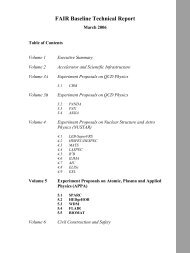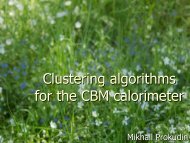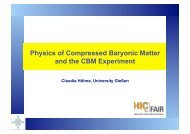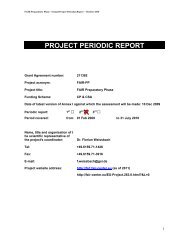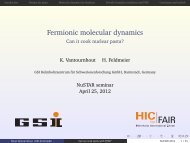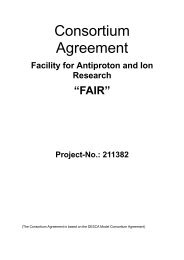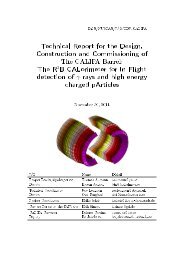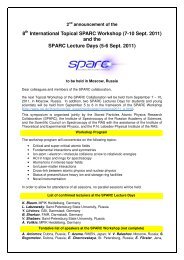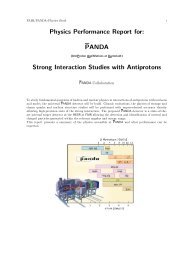NeuLAND - FAIR
NeuLAND - FAIR
NeuLAND - FAIR
You also want an ePaper? Increase the reach of your titles
YUMPU automatically turns print PDFs into web optimized ePapers that Google loves.
decaying into 24 O plus 4 neutrons and the tetra-neutron system. In the next section we<br />
summarize the capabilities and design goals of <strong>NeuLAND</strong>. In chapter 2 we provide a more<br />
detailed view of the various physics cases of R 3 B with emphasis on those cases where<br />
the performance of the newly designed <strong>NeuLAND</strong> is key to crossing borders into new<br />
frontiers, i.e., entering ”Neuland” (terra incognita) in physics with radioactive beams.<br />
1.2. <strong>NeuLAND</strong> Design Goals – General Remarks<br />
The detection of fast neutrons plays a crucial role for the exploration of light and heavy<br />
exotic nuclei towards the neutron dripline. Since the neutron separation thresholds decrease<br />
with increasing neutron-proton asymmetry, the emission of several neutrons after<br />
excitation is the dominant decay process. Neutrons emitted from projectiles with high<br />
velocities in the laboratory frame are kinematically strongly forward focussed, although<br />
isotropically emitted in the projectile rest frame. This allows for a very efficient coverage<br />
of the full solid angle with moderate detector sizes. The excitation energy of the<br />
projectile can be determined, using the invariant-mass technique, from measurements of<br />
the momenta of all emitted particles. The neutron momenta are determined from the<br />
measured position of the interaction in the neutron detector and the time-of-flight from<br />
the target to the neutron detector. The desired resolutions for momenta and thus the<br />
excitation energies, see details in chapter 2, lead to the required spatial resolutions of<br />
σx,y,z ≤ 1.5 cm and a time resolution of σt ≤ 150 ps. The main design goals comprise,<br />
besides the improved resolution, a detection efficiency above 95% for single neutrons<br />
for a wide energy range, a large geometrical acceptance and an excellent multi-neutron<br />
hit reconstruction efficiency. The major achievements in performance, compared to the<br />
present LAND detector, are an improved resolution by a factor of three, the extension of<br />
the very high efficiency for neutrons down to lower energies, and the substantial improvement<br />
of the multi-neutron reconstruction efficiency from a few percent up to 60 percent.<br />
The latter will be a major and necessary advantage for future studies with more neutronrich<br />
systems including nuclear states beyond the neutron dripline. The performance of<br />
the detector is described in great detail in this report on the basis of extensive simulations<br />
and prototype tests. Here, we give a brief overview on the main features with some<br />
examples including large acceptance, high resolution, a large multi-neutron-hit resolving<br />
power, and high efficiency in a very wide energy window.<br />
The active area of the detector of 250 × 250 cm 2 allows to cover the full acceptance<br />
of ±80 mrad determined by the gap of the dipole magnet if the detector is placed<br />
15.5 m downstream of the target. This solid-angle coverage corresponds to a 100%<br />
acceptance (4π) measurement of neutrons with kinetic energies up to around 5 MeV in<br />
the center-of-mass (CM) frame if emitted from a projectile fragment with a kinetic energy<br />
of 600 AMeV. This has to be compared with a typical neutron energy distribution, e.g.,<br />
a Maxwellian distribution of a statistical decay, which peaks at kinetic energies of 1 to<br />
2 MeV and contains more than 90% of the events within the 5 MeV coverage. At higher<br />
beam energies, either a larger acceptance can be chosen (up to about 10 MeV neutron<br />
16





